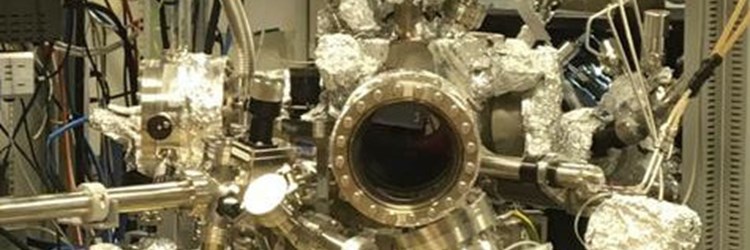

The SFG laboratory exploits non-linear laser spectroscopy for the atomic-level investigation of (electro)catalytic interfaces and 2D materials from UHV to near-ambient pressure and liquid environments
The Laboratory was designed in 2012, and commissioned in 2013, within the framework of the MIUR FIRB2010 project RBFR10J4H7. The installed spectrometer (Ekspla) allows for IR-Vis SFG vibronic spectroscopy investigation of solid-gas, solid-liquid, and liquid-gas interfaces. An IR pulsed laser beam (50 Hz, 30 ps, 1064 nm) is converted into visible (532 nm) and tunable IR (1200-4000 cm-1) radiation that is temporally and spatially overlapped at the sample’s surface. A monochromator and a CCD detector yield scanning-mode data collection. The polarization of the beams can be selected (p and s modes).
An ultra-high vacuum (UHV) system is coupled to the spectrometer. The base pressure of 7x10-11 mbar allows for standard surface science sample preparation, pre- and post-analysis. The installed instrumentation includes an ion gun (Eurovac), a gas line, LEED and AES optics (OCI), RGA, and fast-entry lock for sample loading. The sample can be resistively heated up to 1300 K. Liquid nitrogen cooling is available. Without breaking the vacuum, the sample can be transferred into a reaction cell that is directly aligned with SFG spectrometer (5 degrees of freedom manipulator). Impinging and outgoing light is transferred through BaF2 windows. Achievable reaction conditions in the measurement cell are in the 10-10 – 103 mbar and 300 – 1000 K ranges. Up to three different gas-phase reactants can be used in parallel and mixed.
A dedicated cell is also available for electrochemistry measurements. The setup was initially developed in collaboration with CNR-ICCOM and UniSalento, an updated prototype is being designed in collaboration with PoliMi. Measurements in situ and operando can be performed at an electrode’s surface in the -5/+5 V range at the solid-liquid interface. Electrolyte’s recycling and gas bubbling devices are available. The optical configuration includes a CaF2 prism with micro-channels for the handling of both the electrolyte and the gas bubbles.
Software: The control and data acquisition program of the IR-Vis SFG setup has been customized and further developed in house. Data analysis routines for the normalization and deconvolution of the SFG spectra have been implemented in the Wavemetrics IGOR Pro environment.
Instrumentation: In collaboration with the IOM technical services, we designed, built, and commissioned the cell for the in situ spectroscopy measurements from UHV up to ambient pressure
Nature performs catalytic reactions for the synthesis of energy vectors and organic compounds by exploiting nano-sized or single-atom photosystem and enzymatic catalytic centers, where metals (Mn, Cu, Ni, Fe...) are supported by C, S, or N linkers. Our research is focused on heterogeneous catalytic reaction mechanisms, investigated at the atomic level detail from UHV to near-ambient pressure conditions, occurring at single crystals, nanostructured surfaces, and model catalysts, with an extension to the electro-catalytic environment.
The chemical, electronic, and structural properties are studied experimentally by means of surface science approaches, synchrotron radiation spectroscopies, and in situ and operando IR-Vis Sum-Frequency generation vibronic spectroscopy as implemented in the facility hosted by our lab. Fostering external collaborations, the group exploits ab initio simulations within the framework of Density Functional Theory to yield insight and proper interpretation of the experimental results.